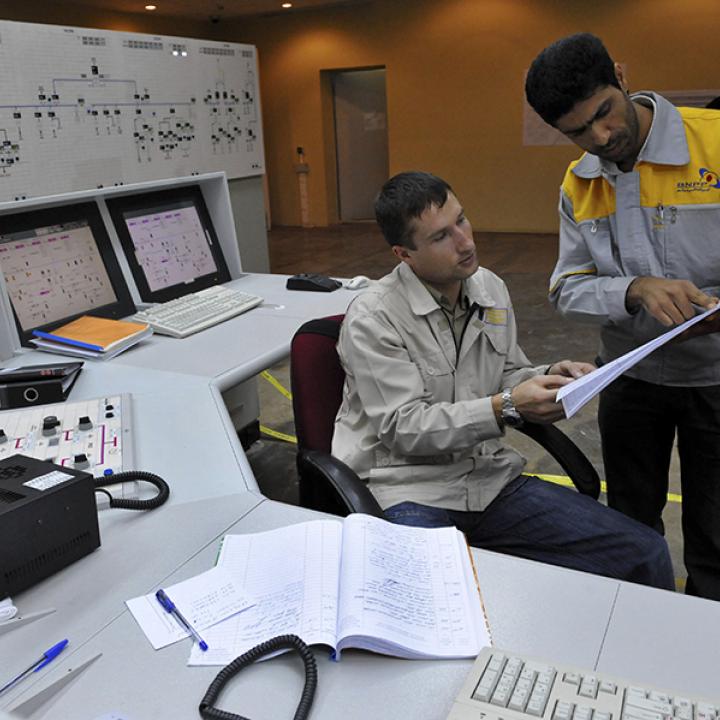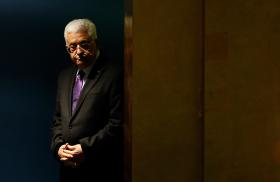

On August 29, 2012, Simon Henderson and Olli Heinonen addressed a Policy Forum at The Washington Institute. Mr. Henderson is the Baker fellow and director of the Gulf and Energy Policy Program at The Washington Institute. Mr. Heinonen, a senior fellow at the Harvard Kennedy School's Belfer Center, previously served as deputy director-general and head of the Department of Safeguards at the International Atomic Energy Agency (IAEA), inspecting nuclear facilities in Iran and other countries. The following is a rapporteur's summary of their remarks.
SIMON HENDERSON
The new study Nuclear Iran: A Glossary of Terms is intended to inform the discussion regarding what should be done about Tehran's nuclear program. The result of many months of collaboration, the report explains the specific techniques and facilities involved in the program since its inception, as well as the physics of nuclear technology, the history of nuclear weapons, and the technical terms used in IAEA reports.
A nuclear bomb can be made from either plutonium or uranium. Plutonium must be obtained by reprocessing material from a power reactor, a rather dangerous but relatively simple chemical process. Yet a country's chances of building a power reactor and producing plutonium without the world noticing are quite small, which makes the uranium route far more attractive to rogue states like Iran.
A centrifuge is a carefully balanced, vertically spinning rotor used to enrich uranium. Natural uranium is mainly composed of the U-238 isotope, but the isotope required for a power reactor or a nuclear weapon is U-235, which makes up only 0.7 percent of natural uranium. Once solid uranium is converted into a gas -- uranium hexafluoride -- it can be spun at high speeds in a centrifuge until the U-235 separates from the U-238. The material is enriched via many stages, steadily removing the excess uranium-238. Stopping at 3.5 percent U-235 is sufficient to fuel power reactors, while going as far as 90 percent produces material suitable for a nuclear submarine or an atomic bomb.
There are basically two forms of atomic bomb. In a "gun-type" device like the one dropped on Hiroshima, one small piece of U-235 is slammed into another, bringing both to critical mass. Simultaneously, extra neutrons are fired at the uranium, prompting a nuclear explosion. Many nuclear weapons designers consider this method crude and prefer the implosion-type bomb, which involves symmetrically compressing a grapefruit-size piece of U-235 into the size of an orange. The United States, Israel, and many other countries fear that Iran is pursuing this kind of device.
Finally, the fact that Iran has so far produced only 20 percent enriched uranium is no cause for comfort. By the time that enrichment level is reached, 90 percent of the physical separation work has been done, so producing weapons-grade material would take comparably little time.
OLLI HEINONEN
If Iran did choose to pursue a nuclear weapon, it would likely do so in secrecy. Tehran has always been deeply committed to concealment regarding its nuclear program. For example, one recent IAEA report showed decontamination activities at the now-defunct Parchin plant, including placement of tarps over the building to conceal those efforts (read the agency's latest report on Iran [PDF]). Similar activities have been recorded at Natanz, where Iran has built a plant that is covered with many feet of concrete and rocks. Additionally, the most controversial site -- the facility in Fordow, located deep under a mountain -- was built entirely in secrecy.
It remains to be seen if the IAEA will ever discover what was at Parchin, which could be the missing link in Iran's nuclear process. Even if the facility no longer exists, explanations must still be pursued, whether by contacting the scientists who performed the experiments or through environmental sampling. At Syria's destroyed al-Kibar reactor, the IAEA was able to find particles of uranium despite the regime's decontamination efforts. Performing similar investigations at Parchin would be difficult but could yield information essential to understanding Iran's capabilities.
Currently, the United States can make several inferences about the Iranian nuclear program. For instance, Tehran is clearly pursuing enriched uranium as a priority rather than plutonium. Although the regime conducted simple plutonium experiments in the early 1990s, its interest in that route quickly waned. It still pursues plutonium production, but not at the same levels as uranium. For example, not much fuel has been produced for the heavy-water reactor in Arak, which would require at least two years to produce enough plutonium for a nuclear device. Processing spent fuel from the Bushehr plant would likewise be an untenable option; at least a year or two must pass before such messy radioactive material can even be handled, and the processing facility would have to be so large that it would be clearly visible in satellite imagery.
Accordingly, Iran is much more likely to stick with uranium enrichment as its path to a nuclear device. If it does achieve 90 percent enrichment, it would still need to convert gaseous uranium hexafluoride into the uranium metal required to build a nuclear weapon. This would not be particularly difficult; the details of that process are in the public domain, and Iran has conducted it before. By next summer, Iran could have enough material, if further enriched, for two nuclear weapons.
Iran uses several kinds of centrifuges to enrich uranium, including the IR-1 and IR-2, and has continually increased its stock of IR-1s. Years ago, the regime announced that it wanted to produce every centrifuge component locally. Most of the necessary high-strength aluminum is likely produced in Iranian factories, though it could also be purchased abroad. At the moment, Iran's stockpile of the raw material required to manufacture IR-1s is unknown.
The regime's other centrifuge type comes in two varieties: the standard IR-2 and the larger IR-2m. Both have been in operation for several years, though Iran has not always been able to feed uranium hexafluoride into IR-2 cascades, perhaps due to faulty designs. The IR-2 is not overly difficult to manufacture, but the raw materials (e.g., the carbon fiber in the rotors) are difficult to acquire in large quantities. These centrifuges must also be subjected to rigorous quality assurance testing to ensure they operate properly, without leaking uranium hexafluoride gas.
In light of these complexities, centrifuge production is a potential weak spot in Iran's nuclear program, one that was targeted by the Stuxnet computer worm in 2010. Yet carrying out another cyber attack on Iranian nuclear facilities seems challenging. Stuxnet's success was based on inside information and access; Tehran has since put systems in place to prevent such an attack, so any new cyber sabotage would have to be done quite differently. The military option is problematic as well. A surgically precise strike would not deter the regime from pursuing nuclear weapons; that would require a sledgehammer. Therefore, an economic solution -- namely, sanctions -- may be the most viable.
This rapporteur's summary was prepared by Katie Kiraly.



